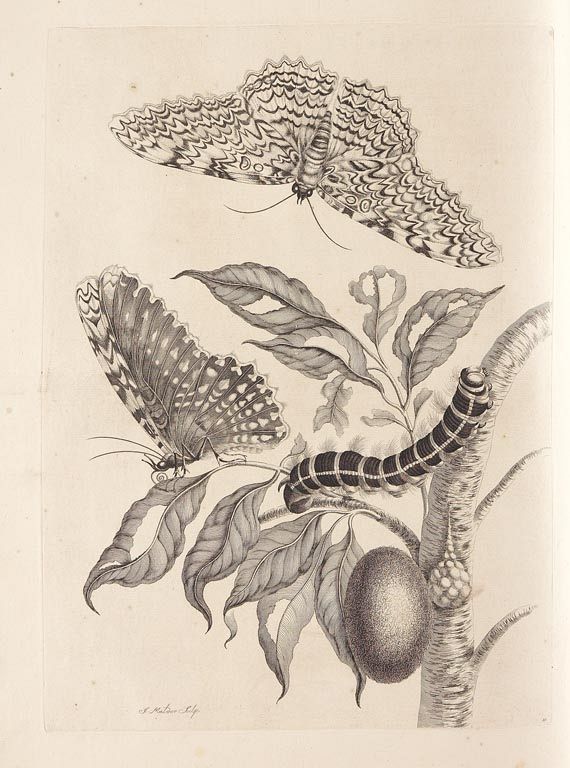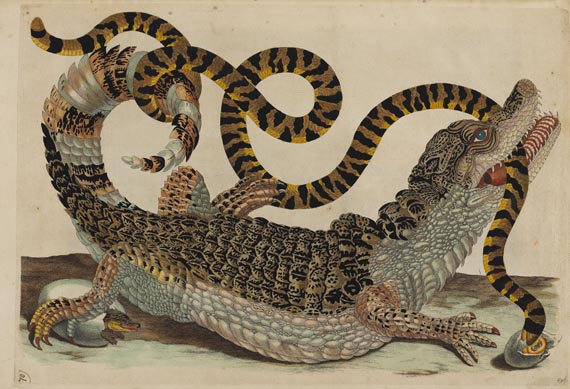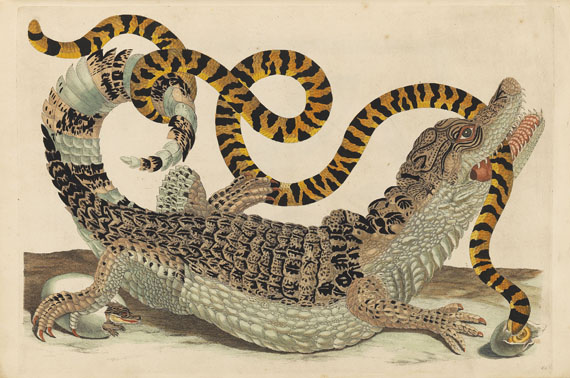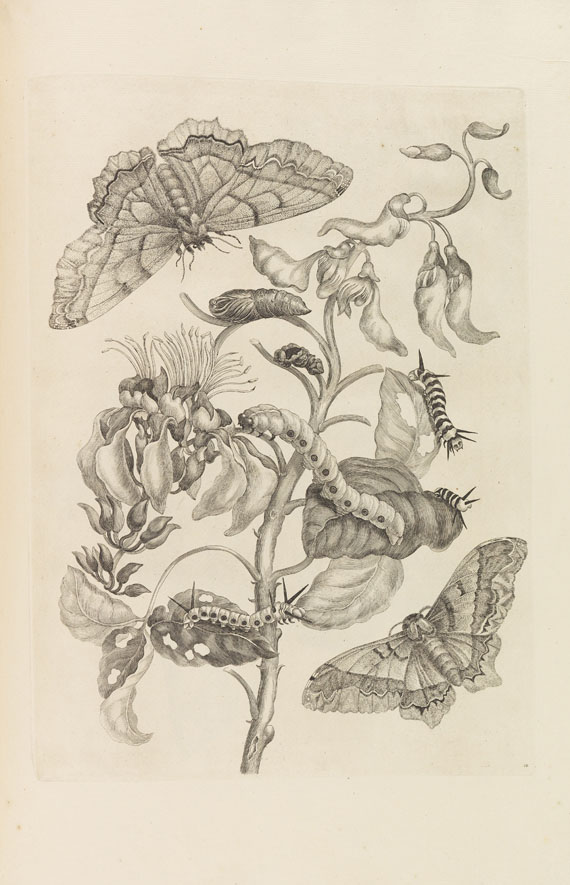Maria Sibylla Merian's great plate books on insects Amsterdam, 1719 & 1730 MERIAN, Maria Sibylla (1647-1717). Dissertatio de generatione et metamorphosibus insectorum Surinamensium. Amsterdam: J. Oosterwyk, 1719. [ With: ] –. De Europische Insecten. Amsterdam: J.F. Bernard, 1730. The works of the naturalist-artist Maria Sibylla Merian whose “careful and deliberate portrayal of insect and host plant together had no precedent in scientific illustration” (Blunt and Stearn). Born in Frankfurt in 1647, Merian was the daughter of the engraver Matthäus Merian and step-daughter of the flower painter Jacob Marrel She studied miniature painting under her step-father’s pupil, Abraham Mignon and became interested in insects from an early age, capturing and drawing specimens from life. Merian’s scientific work is notable for its accurate observation of insect life and transformation in an age when spontaneous generation was still widely accepted. She published the first two parts of her great work on the insects of Europe in 1679 and 1683, and was still immersed in preparing the third part of the Raupenbuch for publication at her death almost 60 years later. The final volume would be completed by her daughters. The present 1730 edition was published by J.F. Bernard, who had purchased the plates of both the completed Raupenbuch and Merians’s very rare first work, Blumenbuch . It includes all 150 insect plates, along with 36 plates of flower designs from Blumenbuch, and represents their first appearance in folio format. After divorcing her husband, Merian and her two daughters spent a period of time living with the Labadist religious community at Castle Waltha, which contained a fine collection of tropical insects brought back from Surinam (then Dutch Guiana) by Cornelius van Sommerdijk. Inspired, she traveled to Surinam with her daughter Dorothea in 1699. The women spent two years recording insects and plants, often aided by enslaved Africans and Indigenous people who brought them specimens and shared traditional knowledge about their properties. The resulting book is “easily the most magnificent work on insects so far produced ... her portrayals of living insects and other animals were imbued with a charm, a minuteness of observation and an artistic sensibility that had not previously been seen in a natural history book” (Dance). First published in 1705, this expanded second edition was printed 1719 with the addition of 12 plates after Merian's elder daughter Johanna. Dunthorne 205; Hunt 467 (1726 ed.) & 483 (French ed.); J. Landwehr, Dutch Books with Coloured Plates , 131 & 136; Nissen BBI 1341 & 1342; Sitwell, p. 119. See Blunt & Stearn, The Art of Botanical Illustration , pp. 142-146 and Peter Dance, The Art of Natural History pp. 50-51. Two works bound in one volume, folio (515 x 350mm). Dissertatio: hand-colored engraved frontispiece by J. Ooserwyck after F. Ottens; title page and dedication leaf with hand-colored engraved vignettes; 4-page preface and introduction; 72 engraved plates, all hand-colored in a contemporary hand (toning and occasional spotting and offsetting throughout, small marginal repairs to frontispiece, marginal tear with loss to plate 61, small marginal dampstain from plates 33 to 41). De Europische Insecten: half-title; title page printed in red and black with hand-colored engraved vignette; 184 engraved plates on 47 leaves, all with contemporary hand-coloring; with hand-colored engraved vignette at end (toning and occasional spotting throughout; small marginal closed tear at bottom of leaves 22 and 23). Contemporary paneled Dutch vellum over paste-boards, blind-stamped panels, fillets and globe motifs on corners, ink titling on spine (rebacked preserving the original spine; a little soiled and rubbed). Provenance: Robert de Belder (1921-1995) and Jelena de Belder-Kovacic (1925-2003) (horticulturists and proprietors of Arboretum Kalmthout in Belgium; their sale, Sotheby’s, 28 April 1987, lot 238).
Maria Sibylla Merian's great plate books on insects Amsterdam, 1719 & 1730 MERIAN, Maria Sibylla (1647-1717). Dissertatio de generatione et metamorphosibus insectorum Surinamensium. Amsterdam: J. Oosterwyk, 1719. [ With: ] –. De Europische Insecten. Amsterdam: J.F. Bernard, 1730. The works of the naturalist-artist Maria Sibylla Merian whose “careful and deliberate portrayal of insect and host plant together had no precedent in scientific illustration” (Blunt and Stearn). Born in Frankfurt in 1647, Merian was the daughter of the engraver Matthäus Merian and step-daughter of the flower painter Jacob Marrel She studied miniature painting under her step-father’s pupil, Abraham Mignon and became interested in insects from an early age, capturing and drawing specimens from life. Merian’s scientific work is notable for its accurate observation of insect life and transformation in an age when spontaneous generation was still widely accepted. She published the first two parts of her great work on the insects of Europe in 1679 and 1683, and was still immersed in preparing the third part of the Raupenbuch for publication at her death almost 60 years later. The final volume would be completed by her daughters. The present 1730 edition was published by J.F. Bernard, who had purchased the plates of both the completed Raupenbuch and Merians’s very rare first work, Blumenbuch . It includes all 150 insect plates, along with 36 plates of flower designs from Blumenbuch, and represents their first appearance in folio format. After divorcing her husband, Merian and her two daughters spent a period of time living with the Labadist religious community at Castle Waltha, which contained a fine collection of tropical insects brought back from Surinam (then Dutch Guiana) by Cornelius van Sommerdijk. Inspired, she traveled to Surinam with her daughter Dorothea in 1699. The women spent two years recording insects and plants, often aided by enslaved Africans and Indigenous people who brought them specimens and shared traditional knowledge about their properties. The resulting book is “easily the most magnificent work on insects so far produced ... her portrayals of living insects and other animals were imbued with a charm, a minuteness of observation and an artistic sensibility that had not previously been seen in a natural history book” (Dance). First published in 1705, this expanded second edition was printed 1719 with the addition of 12 plates after Merian's elder daughter Johanna. Dunthorne 205; Hunt 467 (1726 ed.) & 483 (French ed.); J. Landwehr, Dutch Books with Coloured Plates , 131 & 136; Nissen BBI 1341 & 1342; Sitwell, p. 119. See Blunt & Stearn, The Art of Botanical Illustration , pp. 142-146 and Peter Dance, The Art of Natural History pp. 50-51. Two works bound in one volume, folio (515 x 350mm). Dissertatio: hand-colored engraved frontispiece by J. Ooserwyck after F. Ottens; title page and dedication leaf with hand-colored engraved vignettes; 4-page preface and introduction; 72 engraved plates, all hand-colored in a contemporary hand (toning and occasional spotting and offsetting throughout, small marginal repairs to frontispiece, marginal tear with loss to plate 61, small marginal dampstain from plates 33 to 41). De Europische Insecten: half-title; title page printed in red and black with hand-colored engraved vignette; 184 engraved plates on 47 leaves, all with contemporary hand-coloring; with hand-colored engraved vignette at end (toning and occasional spotting throughout; small marginal closed tear at bottom of leaves 22 and 23). Contemporary paneled Dutch vellum over paste-boards, blind-stamped panels, fillets and globe motifs on corners, ink titling on spine (rebacked preserving the original spine; a little soiled and rubbed). Provenance: Robert de Belder (1921-1995) and Jelena de Belder-Kovacic (1925-2003) (horticulturists and proprietors of Arboretum Kalmthout in Belgium; their sale, Sotheby’s, 28 April 1987, lot 238).




.jpg)










Testen Sie LotSearch und seine Premium-Features 7 Tage - ohne Kosten!
Lassen Sie sich automatisch über neue Objekte in kommenden Auktionen benachrichtigen.
Suchauftrag anlegen